TBI Food Secrets: The Fascinating History of Rasgulla and the ‘Sweet’ Battle Over its Origin
If there has been one sweet dish that has been a true 'game changer' of the way sweets are perceived and eaten in India, it has to be the luscious rasgulla. This story traces the interesting origins of this iconic Indian sweet.
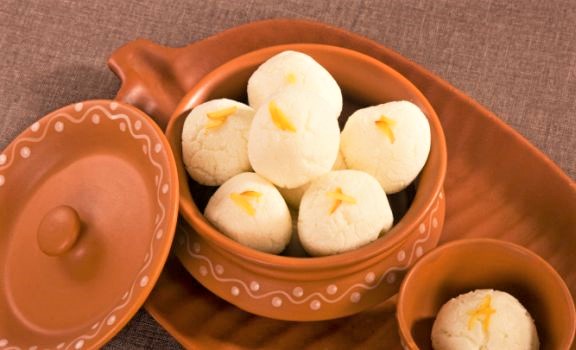
From the bylanes of Kolkata and the temples of Puri to the power corridors of Rashtrapati Bhawan, Rasgulla remains one of India’s best-loved culinary inventions. The Bengalis stake their claim on it. The Oriyas believe it’s their invention. And the world cannot seem to have enough of the sweet, also known as rosogolla, roshogollah or rasbari (depending which Indian state it is being referred in).
If there has been one sweet dish that has been a true ‘game changer’ of the way sweets are perceived and eaten in India, it has to be the luscious rasgulla – or how famous British chef William Harold described it in a journal – “a bowl of sweet, syrupy, soft cheese balls.”
So if you are a die-hard fan of this delicious sweet, take things up a notch and tease your taste buds a little more with the story of what makes rasgulla so extraordinary.
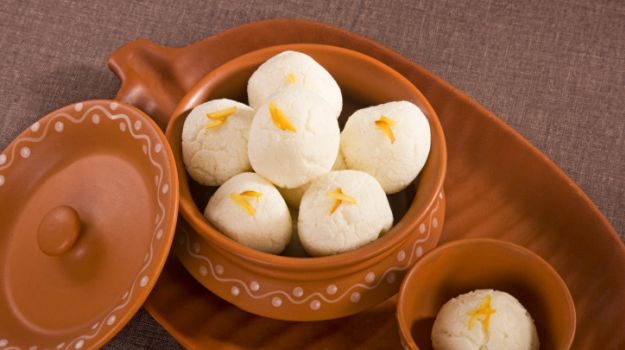
Photo Source
History reveals some interesting facts about the origins of this celebrated Indian sweet. Many Odias claim that the answer lies in the history of Puri in Odisha, where this 700-year-old sweet dish was part of a ritual. The legend goes that Lord Jagannath offered the sweets to his consort Lakshmi, to pacify her for not being taken along during the Rath Yatra or ritual chariot ride.
Known as khira mohana due to its almost white appearance back in the 11th century, it thus became customary to offer this chenna sweet dish to Goddess Mahalakshmi as prasad, especially on the last day of the Rath Yatra, also called Niladri Vijay.
You May Like: TBI Food Secrets: The Fascinating History Behind Rajasthan’s Traditional Dish Dal Baati Churma
How did the sweet dish reach out of the temple’s periphery given that temples kept their recipes well guarded is unknown. But folklore has it that it was one of the priests who began teaching people the art of milk curdling and making rasgulla after he saw villagers throwing excess milk.
Interestingly, for the villagers of Pahala (a hamlet in the outskirts of Bhubaneswar) this came as a blessing in disguise. This tiny hamlet was in fact home to more cows than humans, and milk was always in excess. With the villagers quickly learning the the method of making chenna (curdled cheese), Pahala soon emerged as Odisha’s rasgulla hub. The rasgulla produced here, brownish in colour due to hard baking compared to the white ones prevalent in Kolkata, are sold throughout the state.
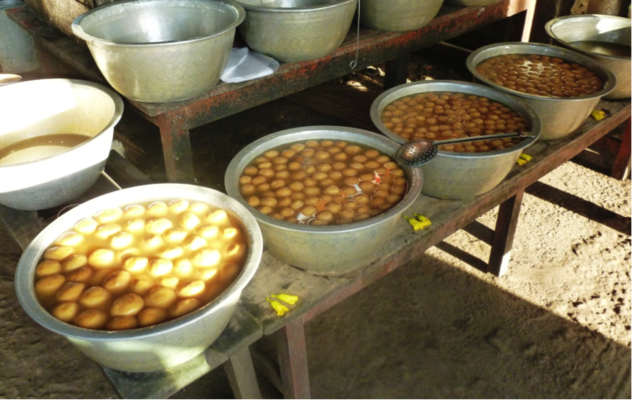
The other variant of rasgulla that Odisha is famous for is the one from Salepur (yet another rasgulla making hamlet in Odisha near Cuttack). Bigger, softer, creamier with a velvety cream like appearance, this variation of khira mohana was developed by a local confectioner, Bikalananda Kar.
The technique of steaming the cheese balls and then allowing them to slowly rise in the sugar syrup was a technique that was mastered by him. The Odias believe that this is how the modern-day rasgulla originated.
West Bengal, the state synonymous with the quintessential rasgulla, could hardly have taken this claim lying down. Also, now that we are talking about Bengalis, lets just call it roshogolla! Pronounced ‘raw-show-golla‘, the Bengalis claim that it was developed by Calcutta gentleman Nabin Chandra Das in 1868 and popularised by the following generations of his family.
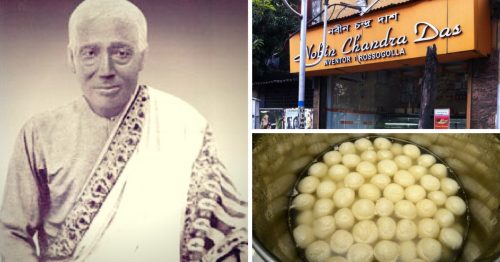
Photo Source
In Kolkata, Dhiman Das, the great great-grandson of Nabin Chandra Das, often tells the story of how the legendary sweetmaker invented the rasgulla:
“Nabin Chandra Das first established a sweet shop in Jorashanko in 1864. But he went out of business soon and after two years, he opened another establishment in Bagbazar. Determined that he would not peddle run-of-the-mill sweets, he wanted to invent a sweet that would solely be his creation.
Das tried to boil chenna balls in sugar syrup, but they would just disintegrate. He finally resolved the problem by using reetha and creating bubbles that would lend a sponginess to the chenna balls. After sustained effort, he was able to master the art of holding the balls together, and thus was born rasgulla. His customers loved it.
In spite of well-wishers advising him to patent his creation, Das then taught the intricacies of the art to various sweetmeat makers because he believed that his creation would become famous only if it was available across the country.”
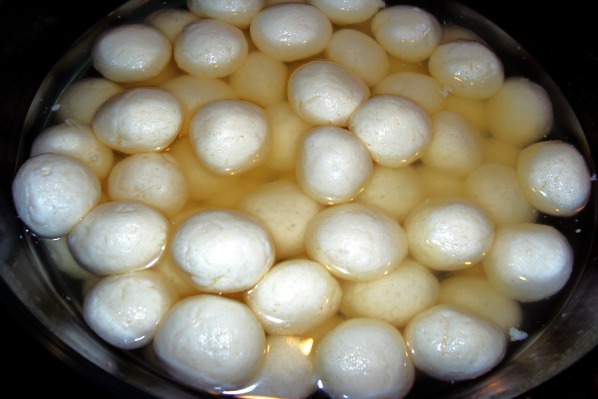
Photo Source
Das’s invention became a huge success among Bengalis. Legend has it that Pashupati Bhattacharya, a famous medical practitioner of Bagbazar, used to carry Das’s rasgulla whenever he visited Rabindranath Tagore. Once, the shop had run out of stock when Bhattacharya arrived. As a result, he had to purchase the sweet from a nearby shop. Tagore felt the difference at once and asked the doctor to bring rasgulla from Das’s shop only.
You May Like: TBI Food Secrets: Unravelling the Fascinating History of the Samosa, India’s Favourite Street Snack
The other popular tale is that the famous Haradhan Moira, sweet-maker of the Pal Chowdhurys of Ranaghat, inventing the rasgulla by accidentally dropping some chenna balls into bubbling syrup. In the late 19th and early 20th century, two confectioneries -the Mullicks of Bhowanipore (this later became Balaram) and Chittaranjan Mistana Bhandar of Sobhabazar -further fine-tuned the delicious sweet.
The story goes that Bhagwandas Bagla, a wealthy non-Bengali merchant residing in Kolkata, travelled with sweet across India, resulting in new regional variations. It became rasbari in Rajasthan, rajbhog in UP, rasmalai in Benaras and even the official ‘cheese dumplings’ treat in the offices of the East India Company. In 1930, the rasgulla was canned and exported to different countries by KC Das and gained popularity across the globe.
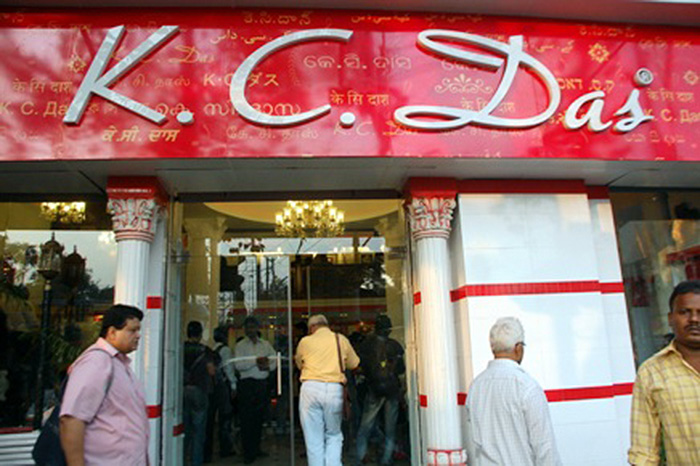
Photo Source
Here is an interesting anecdote about the deep fondness British colonial rulers in India harboured for the rasgulla.
William Harold was a famous British cook who was sent to India to help with the war efforts. His dishes were so delicious that a high ranking officer, who tried one of dishes, ultimately promoted him to be his personal cook. One day, the officer ordered William to fetch the recipe of the rasgulla, a local dish he ate and fell in love with.
Back then, written recipes were very few and very between, so William had to physically walk from home to home, knocking on every door, in order to get hold of that recipe. Howevre, in spite of his on-field research, he failed to acquire the recipe of the rasgulla.
Every home he visited gave him a different recipe and a different technique to work with. Unable to replicate the result, Harold left the country with 10 boxes of rasgulla and the hope that he would eventually be able to recreate the dish. Whether he ever succeeded in doing so remains a mystery.

Photo Source
With so much tradition and history invested in it, Kolkata is unlikely to give up its claim as the iconic sweet’s birthplace. Ever since both the governments asking for a Geographical Indication in 2015, the sweet has found itself at the centre of an interesting tug of war. Odia litterateurs say the sweet is mentioned in many works that were written well before 1868. For instance, the ancient Odia dictionary ‘Purnachandra Bhasakosha‘ talks of a cheese sweet in jaggery syrup.
Odisha is also citing Pundit Suryanarayan Dash’s Sahitya Akademi award-winning ‘Odia Sahitya ra Itihasa‘, which mentions ‘Dandi Ramayan‘ and its pointers to Odia food including rasgulla. Some Odia enthusiasts have even called for observation of Rasgulla Diwas, coinciding with the Rath Yatra of the three revered deities of Puri’s Jagannath Temple.
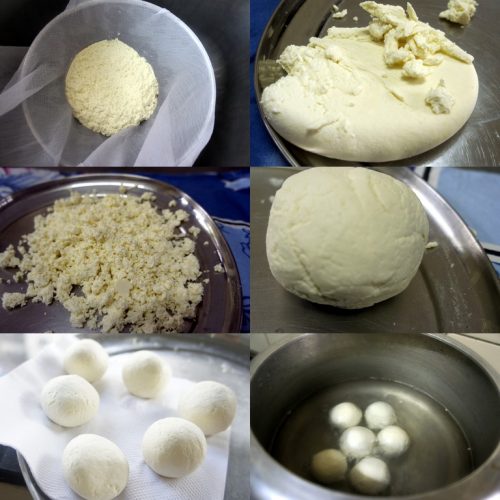
Photo Source
On the other, West Bengal is preparing a detailed dossier on historical evidence compiled in collaboration with K C Das, the sweet chain founded and run by Nabin Chandra Das’s descendants. Their key argument, also pointed out by food historian KT Achaya, is that Bengalis learnt how to make chenna from the Portuguese and were the first to experiment with it for their sweets. Elsewhere in India, the separation of the chenna from the milk was thought of as sacrilege since milk was offered to the gods.
In short, the jury is still out on who owns the sweet. Maybe it was invented in Bengal and taken to Odisha. Maybe the Odiya cooks of Bengali households bought it to Bengal. Given the lack of records, it is impossible to tell. However, one thing is more certain: given its history, and also the fact that it is now almost a pan-India food, any Geographical Indication claims that either Odisha or West Bengal might make on the rasgulla would be just a little unfair and unnecessary. After all, the best thing to do with a rasgulla is to eat it!
Update: The legal battle between Bengal and Odisha has finally come to an end, with the coveted Geographical Identification (GI) tag on rasgulla being awarded to West Bengal on November 14, 2017.
Also Read: Food Secrets: 20 Delectable Indian Sweets You Probably Haven’t Heard Of, But Must Try Right Away!
Like this story? Have something to share? Email: contact@thebetterindia.
NEW! Log into www.gettbi.com to get positive news on Whatsapp.
If you found our stories insightful, informative, or even just enjoyable, we invite you to consider making a voluntary payment to support the work we do at The Better India. Your contribution helps us continue producing quality content that educates, inspires, and drives positive change.
Choose one of the payment options below for your contribution-
By paying for the stories you value, you directly contribute to sustaining our efforts focused on making a difference in the world. Together, let’s ensure that impactful stories continue to be told and shared, enriching lives and communities alike.
Thank you for your support. Here are some frequently asked questions you might find helpful to know why you are contributing?


This story made me
-
97
-
121
-
89
-
167













